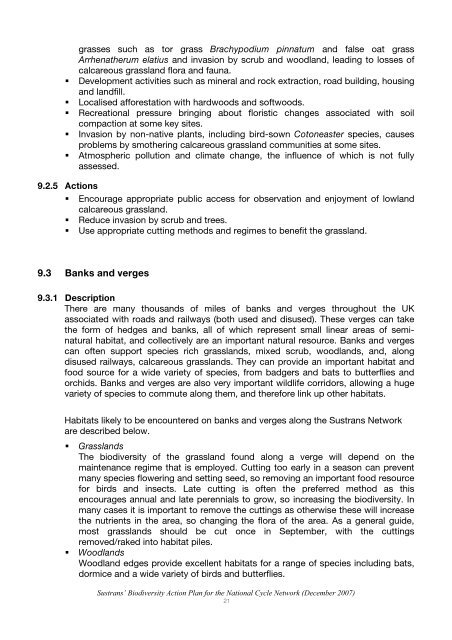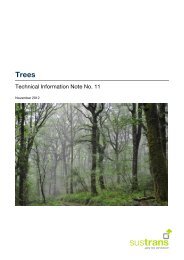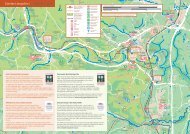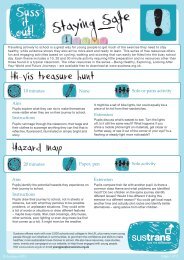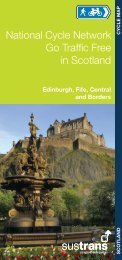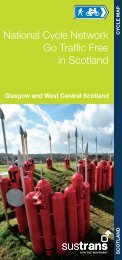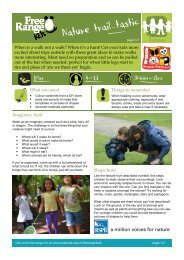Biodiversity Action Plan for the National Cycle Network ... - Sustrans
Biodiversity Action Plan for the National Cycle Network ... - Sustrans
Biodiversity Action Plan for the National Cycle Network ... - Sustrans
You also want an ePaper? Increase the reach of your titles
YUMPU automatically turns print PDFs into web optimized ePapers that Google loves.
grasses such as tor grass Brachypodium pinnatum and false oat grass<br />
Arrhena<strong>the</strong>rum elatius and invasion by scrub and woodland, leading to losses of<br />
calcareous grassland flora and fauna.<br />
Development activities such as mineral and rock extraction, road building, housing<br />
and landfill.<br />
Localised af<strong>for</strong>estation with hardwoods and softwoods.<br />
Recreational pressure bringing about floristic changes associated with soil<br />
compaction at some key sites.<br />
Invasion by non-native plants, including bird-sown Cotoneaster species, causes<br />
problems by smo<strong>the</strong>ring calcareous grassland communities at some sites.<br />
Atmospheric pollution and climate change, <strong>the</strong> influence of which is not fully<br />
assessed.<br />
9.2.5 <strong>Action</strong>s<br />
Encourage appropriate public access <strong>for</strong> observation and enjoyment of lowland<br />
calcareous grassland.<br />
Reduce invasion by scrub and trees.<br />
Use appropriate cutting methods and regimes to benefit <strong>the</strong> grassland.<br />
9.3 Banks and verges<br />
9.3.1 Description<br />
There are many thousands of miles of banks and verges throughout <strong>the</strong> UK<br />
associated with roads and railways (both used and disused). These verges can take<br />
<strong>the</strong> <strong>for</strong>m of hedges and banks, all of which represent small linear areas of seminatural<br />
habitat, and collectively are an important natural resource. Banks and verges<br />
can often support species rich grasslands, mixed scrub, woodlands, and, along<br />
disused railways, calcareous grasslands. They can provide an important habitat and<br />
food source <strong>for</strong> a wide variety of species, from badgers and bats to butterflies and<br />
orchids. Banks and verges are also very important wildlife corridors, allowing a huge<br />
variety of species to commute along <strong>the</strong>m, and <strong>the</strong>re<strong>for</strong>e link up o<strong>the</strong>r habitats.<br />
Habitats likely to be encountered on banks and verges along <strong>the</strong> <strong>Sustrans</strong> <strong>Network</strong><br />
are described below.<br />
<br />
<br />
Grasslands<br />
The biodiversity of <strong>the</strong> grassland found along a verge will depend on <strong>the</strong><br />
maintenance regime that is employed. Cutting too early in a season can prevent<br />
many species flowering and setting seed, so removing an important food resource<br />
<strong>for</strong> birds and insects. Late cutting is often <strong>the</strong> preferred method as this<br />
encourages annual and late perennials to grow, so increasing <strong>the</strong> biodiversity. In<br />
many cases it is important to remove <strong>the</strong> cuttings as o<strong>the</strong>rwise <strong>the</strong>se will increase<br />
<strong>the</strong> nutrients in <strong>the</strong> area, so changing <strong>the</strong> flora of <strong>the</strong> area. As a general guide,<br />
most grasslands should be cut once in September, with <strong>the</strong> cuttings<br />
removed/raked into habitat piles.<br />
Woodlands<br />
Woodland edges provide excellent habitats <strong>for</strong> a range of species including bats,<br />
dormice and a wide variety of birds and butterflies.<br />
<strong>Sustrans</strong>’ <strong>Biodiversity</strong> <strong>Action</strong> <strong>Plan</strong> <strong>for</strong> <strong>the</strong> <strong>National</strong> <strong>Cycle</strong> <strong>Network</strong> (December 2007)<br />
21


